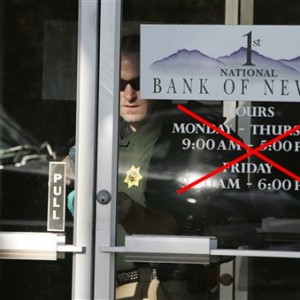 Do you know if your bank will be there next month? For a growing number of Americans, that is becoming a very real question. The Wall Street Journal is reporting that 775 banks (approximately ten percent of all U.S. banks) are now on the Federal Deposit Insurance Corporation’s list of “problem” banks. This year we have already seen more than six dozen banks fail, and the frightening thing is that we are seeing a rapid acceleration in bank failures even though we are supposedly in a “recovery” right now. So what happens if the economy takes a bad turn and hundreds of these banks that are barely surviving start failing?
Do you know if your bank will be there next month? For a growing number of Americans, that is becoming a very real question. The Wall Street Journal is reporting that 775 banks (approximately ten percent of all U.S. banks) are now on the Federal Deposit Insurance Corporation’s list of “problem” banks. This year we have already seen more than six dozen banks fail, and the frightening thing is that we are seeing a rapid acceleration in bank failures even though we are supposedly in a “recovery” right now. So what happens if the economy takes a bad turn and hundreds of these banks that are barely surviving start failing?
Right now an increasing number of Americans are not paying their loans, and this is shredding the balance sheets of small and medium size banks all over the United States. In fact, during the first quarter of 2010, the total number of loans that are at least three months past due increased for the 16th consecutive quarter.
16 consecutive quarters?
Once is a coincidence.
Twice is a trend.
Sixteen times in a row is a total nightmare.
Is there anyone out there that is still convinced that the economy is getting better?
If so, perhaps this will convince you otherwise….
There were 252 banks on the FDIC’s “problem list” at the end of 2008.
There were 702 banks on the FDIC’s “problem list” at the end of 2009.
Now there are 775 banks of the FDIC’s “problem list”.
Are you starting to see a trend?
Federal regulators have already closed 73 banks in 2010, more than double the number shut down at this time last year.
The truth is that the U.S. banking system is coming apart like a 20 dollar suit.
So is the FDIC worried?
No, they insist that they have plenty of money to cover all of the banks that are going to fail.
After all, the FDIC’s deposit insurance fund now has negative 20.7 billion dollars in it, which represents a slight improvement from the end of 2009.
Yes, you read that correctly.
Negative 20.7 billion dollars.
That should be enough to cover the hundreds of banks that are in the process of failing, right?
Well, if not, the FDIC can just run out and ask the U.S. government for a big, juicy bailout.
After all, can’t the U.S. government borrow an endless amount of money with absolutely no consequences?
Well, no.
Debt always catches up with you sooner or later.
In fact, the IMF is warning that that the gross public debt of the United States will hit 97 percent of GDP in 2011 and 110 percent of GDP in 2015.
Meanwhile, the U.S. financial system continues to shrink even after the unprecedented amount of “stimulus money” that the U.S. government has been shoveling into the economy.
The M3 money supply is now contracting at a frightening pace.
In fact, the current rate of monetary contraction now matches the average rate of monetary contraction the U.S. experienced between 1929 and 1933.
But don’t worry.
We aren’t going into a Depression.
Everything is going to be just fine.
Just look deep into Obama’s eyes and keep repeating the word “change” to yourself over and over.
According to a report in The Telegraph, the M3 money supply declined from $14.2 trillion to $13.9 trillion in the first quarter of 2010.
That represents an annual rate of contraction of 9.6 percent.
In case you were wondering, that is a lot.
Not only that, but the assets of institutional money market funds declined at a 37 percent annual rate.
That was the sharpest drop ever.
Yes, it is time for the alarm bells to start going off.
The Telegraph recently quoted Professor Tim Congdon from International Monetary Research as saying the following about the deep problems that the U.S. is facing….
“The plunge in M3 has no precedent since the Great Depression. The dominant reason for this is that regulators across the world are pressing banks to raise capital asset ratios and to shrink their risk assets. This is why the US is not recovering properly.”
If banks continue to cut their lending, the M3 is going to continue to shrink.
But as noted above, Americans are increasingly getting behind on their loans, so why should banks loan money to a bunch of deadbeats?
Right now U.S. banks are increasingly tightening their lending standards, and this is making it much tougher to get a loan.
In fact, in 2009 the biggest U.S. banks posted their sharpest decline in lending since 1942.
But there is only one problem.
The U.S. economy is completely and totally dependent on credit.
Without easy credit, the entire U.S. economic machine is going to slowly grind to a halt.
So what do you do?
The reality is that we have one gigantic financial mess on our hands, and in many ways it is starting to look like the 1930s all over again.
But perhaps someone out there has a way to get us out of this nightmare. Please feel free to leave a comment with your thoughts, opinions or solutions….
